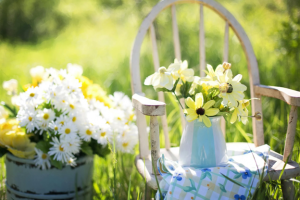Gardening is a rewarding hobby that brings joy and beauty to your home. However, ensuring that your garden plants thrive requires more than just planting seeds and watering them occasionally. It involves understanding the needs of each plant and providing the right conditions for growth. This guide outlines six essential ways to ensure your garden plants flourish, covering everything from soil quality to pest management.
1. Choose the Right Plants for Your Climate
Selecting plants that are well-suited to your local climate is crucial for their survival and growth. Research the hardiness zone of your area and choose plants that can thrive in those conditions. Native plants are often the best choice, as they are adapted to the local weather patterns and soil types.
Consider the amount of sunlight your garden receives throughout the day. Some plants require full sun, while others thrive in partial shade. Group plants with similar light requirements together to ensure they receive the appropriate amount of sunlight. Additionally, be mindful of the seasonal changes in your region and choose plants that can withstand temperature fluctuations.
2. Prepare and Maintain Healthy Soil
Healthy soil is the foundation of a thriving garden. Start by testing your soil to determine its pH level and nutrient content. Most plants prefer a slightly acidic to neutral pH range (6.0-7.0). Based on the test results, amend your soil with organic matter such as compost, manure, or peat moss to improve its structure and fertility.
Regularly adding organic matter to your soil helps maintain its health by improving water retention, drainage, and aeration. Mulching your garden beds with organic materials like straw, leaves, or wood chips can also help conserve moisture, suppress weeds, and regulate soil temperature. Remember to avoid compacting the soil, as this can restrict root growth and water penetration.
3. Water Wisely and Consistently
Proper watering is essential for plant health, but it can be tricky to get right. Overwatering and underwatering can both be detrimental to plants. The key is to water deeply and infrequently, allowing the soil to dry out slightly between waterings. This encourages plants to develop deep root systems, making them more resilient to drought.
Water your garden early in the morning or late in the evening to minimize evaporation and ensure that the water reaches the roots. Use a soaker hose or drip irrigation system to deliver water directly to the soil, reducing the risk of fungal diseases that can occur with overhead watering. Be mindful of the specific water needs of different plants and adjust your watering schedule accordingly.
4. Provide Adequate Nutrients
Plants need a variety of nutrients to grow strong and healthy. The three primary nutrients are nitrogen (N), phosphorus (P), and potassium (K), often referred to as NPK. Each nutrient plays a different role in plant growth: nitrogen promotes leafy growth, phosphorus supports root development and flowering, and potassium enhances overall plant health.
Fertilize your plants with a balanced fertilizer or one tailored to their specific needs. Organic fertilizers, such as compost, bone meal, and fish emulsion, are excellent choices as they release nutrients slowly and improve soil health over time. Be sure to follow the recommended application rates and timing to avoid over-fertilizing, which can harm plants and the environment.
5. Protect Your Plants from Pests and Diseases
Pests and diseases can quickly devastate a garden if left unchecked. Regularly inspect your plants for signs of trouble, such as discolored leaves, holes, or unusual growth patterns. Early detection allows for more effective intervention. At harpersnurseries.com, you can find a variety of gardening gear to help protect your plants from pests and diseases. Use physical barriers like row covers or netting to keep insects and animals away from your plants.
Encourage beneficial insects, such as ladybugs and lacewings, by planting flowers that attract them. These insects prey on common garden pests and help keep their populations in check. Additionally, practice crop rotation and plant diversity to reduce the risk of disease and pest buildup.
6. Prune and Deadhead Regularly
Pruning and deadheading are essential maintenance tasks that promote healthy growth and flowering. Pruning involves removing dead, damaged, or overgrown branches to improve air circulation and light penetration. This helps prevent diseases and encourages the plant to produce new growth.
Deadheading, or removing spent flowers, prevents plants from setting seed and directs their energy toward producing more blooms. This is particularly important for annuals and perennials that flower repeatedly throughout the growing season. Use clean, sharp tools to make precise cuts and minimize damage to the plant.
Ensuring your garden plants thrive requires a combination of proper plant selection, soil preparation, watering, nutrient management, pest control, pruning, and seasonal planning. By following these six essential tips, you can create a thriving garden that brings beauty and joy to your home. Remember, gardening is a continuous learning process, so stay curious, observe your plants, and adapt your practices to meet their needs.


